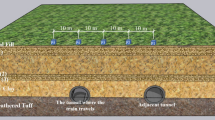Abstract
Urban trains running on ground surface lead to evironmental ground vibrations in the vicinity of railwaylines. The complicated vibration source of the system can hardly be measured directly. The inversion methodology in engineering seismology is borrowed here to study the dynamic exciting sourec, i.e., the wheel-rail unevenness. A dynamic coupled train-track-3D ground model is combined with a genetic algorithm for the inversion. The solution space of the inversion variables, the objective function and the solving genetic strategy of the inversion are determined, and a joint inversion for the wheel-rail unevenness source function and some track structure parameters is therefore designed. The wheel-rail unevenness PSD, being the source function of No. 13 Beijing urban railway, is obtained by the inversoin based on observed data in the field. The result indicates that the source function discribes the track unevenness in the range of wavelength over 1.2 m, and reflects properly wheel irregularites in the range of wavelength shorter than 1.2 m. It should be noticed that the urban rail traffic is not very fast, and this range of short wavelength is exactly corresponding to the main frequency band of environmental vibrations from the traffic. The unevenness of wavelength under 1.2 m is underestimated, and the ground vibration in the main frequency band must be underestimated consequently, if the track unevenness spectrum is taken as the source function. Rather than the track spectrum reflecting just the evenness of track, the wheel-rail spectrum expresses both the track unevenness and the irregularities of wheels, and therefore is more suitable to be the source function of urban railway traffic. It is also convinced that the exciting source inversion according to observed ground vibrations is an effective way to detect quantitatively the combined wheel-rail unevenness.
Similar content being viewed by others
References
Hu X Y, Xiong F. Response analysis of microvibration of high technology building (in Chinese). Earthq Eng Eng Vib, 2006, 26: 56–62
Gupta S, Liu W F, Degrande G, et al. Prediction of vibrations induced by underground railway traffic in Beijing. J Sound Vib, 2008, 310: 608–630
Bata M. Effects on buildings of vibrations caused by traffic. Building Sci, 1971, 6: 221–246
Xia H, Cao Y M. Problem of railway traffic induced vibrations of environments (in Chinese). J Rai Sci Eng, 2004, 1: 44–51
Sheng X, Jones C J C, Thompson D J. A comparison of a theoretical model for quasi-statically and dynamically induced environmental vibration from trains with measurements. J Sound Vib, 2003, 267: 621–635
Sheng X, Jones C J C, Thompson D J. A theoretical model for ground vibration from trains generated by vertical track irregularities. J Sound Vib, 2004, 262: 937–965
Lombaert G, Degrande G, Kogut J, et al. The experimental validation of a numerical model for the prediction of railway induced vibrations. J Sound Vib, 2006, 297: 512–535
Galvin P, Francois S, Schevenels M, et al. A 2.5D coupled FE-BE model for the prediction of railway induced vibrations. Soil Dyn Earthq Eng, 2010, 30: 1500–1512
Lombaert G, Degrande G. Ground-borne vibration due to static and dynamic axle loads of Intercity and high-speed trains. J Sound Vib, 2009, 319: 1036–1066
Sheng X, Jones C J C, Thompson D J. Prediction of ground vibration from trains using the wavenumber finite and boundary element methods. J Sound Vib, 2006, 293: 575–586
Dings P C, Dittrich M G. Roughness on Dutch railway wheels and rails. J Sound Vib, 1996, 193: 103–112
Luo L, Zhang G M, Wu W Q, et al. Evenness Control of Wheel-rail System (in Chinese). Beijing: China Railway Press, 2006. 1–11
Xia H, Zhang N. Dynamic Interaction of Vehicles and Structures (in Chinese). 2nd ed. Beijing: Science Press, 2005. 93–97
Zhai W M. Vehicle-track Coupling Dynamics (in Chinese). 3rd ed. Beijing: Science Press, 2007. 88–91
Wang F T, Tao X X, Zheng X, et al. PSD Correction method for removing background vibration from traffic environmental vibration observation (in Chinese). J Vib Shock, 2011, 30: 137–141
Wang F T, Tao X X, Cui G H, et al. In situ experimental study on free field ground vibration near urban railway line (in Chinese). J Vib Shock, 2011, 30: 129–132
Sheng X, Jones C J C, Petyt M. Ground vibration generated by a load moving along a railway track. J Sound Vib, 1999, 228: 129–156
Krishnakumar K. Micro-genetic algorithms for stationary non-stationary function optimization. In: Intelligent Control and Adaptive Systems, SPIE Proceedings, 1989, 1196: 289–296
Zheng X, Tao X X, Wang F T. Virtual inversion of vibration source parameters of wheel-rail impact (in Chinese). J HIT, 2010, 42: 1232–1234
Tao X X, Wang F T, Zheng X, et al. Validation of an inversion scheme for source of ground vibration near to urban railway. In: Proc 4th ISEV, 2009. 79–84
Zheng X, Tao X X, Wang F T. Virtual inversion of vibration source on surface of single soil layer overlaid on elastic half-space. In: Proc 4th ISEV, 2009. 532–537
Tao X X, Shi L J. Virtual inversion of ground wave velocity structure by microtremors array observation (in Chinese). Earthquake Engineering and Disaster Mitigation Facing the New Century. Beijing: Earthquake Press, 2002. 443–452
Author information
Authors and Affiliations
Corresponding author
Rights and permissions
About this article
Cite this article
Wang, F., Tao, X. & Zheng, X. Inversion of excitation source in ground vibration from urban railway traffic. Sci. China Technol. Sci. 55, 950–959 (2012). https://doi.org/10.1007/s11431-011-4665-9
Received:
Accepted:
Published:
Issue Date:
DOI: https://doi.org/10.1007/s11431-011-4665-9




